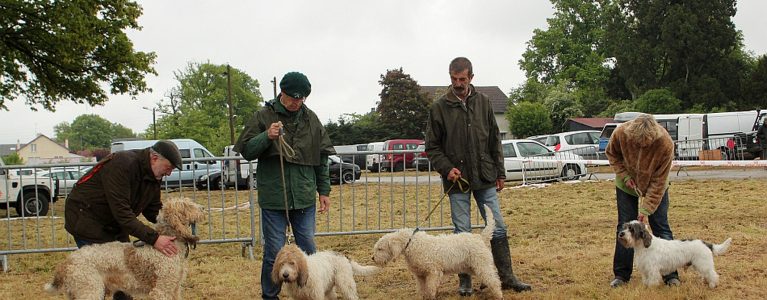
Interview with Nicolette Jentink, treasurer of breed club Club du Griffon Vendéen des Pay-Bas.
Nicolette Jentink just loves her two Grand Bassets Griffons Vendéen. “I especially like their character. A Griffon goes his own way, because he likes to hunt and trace. It is a nice challenge to get them under reasonable control. I say reasonable, because they chase a rabbit when they smell one! They are also very friendly. Because the hunt used to be in a group, they aren’t aggressive towards other dogs. The only disadvantage? It’s a challenge to find a good groomer”, she smiles.
Nicolette is treasurer of the Club du Griffon Vendéen des Pays-Bas. The club manages the interests of four breeds: the Petit and Grand Basset Griffon Vendéen, Grand Griffon Vendéen and the Briquet Griffon Vendéen. “The Grand Griffon Vendéen is kept in the Netherlands, but hardly anyone breeds this race. I think it’s because these dogs are quite large and are not so popular because of their size. Also the Briquet is hard to find in the Netherlands. As far as I know, there are no Dutch Briquet breeders. In our country the Petits Bassets are most popular. But don’t be mistaken by their size, because also the Petit is a great hunter!”
The Club was founded in 1985. “We don’t have much members,” says Nicolette, “but we are very active. We have club matches, days to judge descendants, family days, walks and of course hunts. Hunting in the Netherlands is merely a form of bloodtracking. Griffons can be used for tracking wildlife after a hit with a car. When the dog finds the wounded animal, this animal can be helped or put out of misery. Some Griffons also work as a rescue dog or mantrailing, where they search for missing persons. The hunt is very important for a Griffon Vendéen. You mustn’t only get them tired physically, but also mentally. That’s why many of our members go abroad for hunting trials.”
The Club du Griffon Vendéen des Pays-Bas thinks it’s important to keep track of the history of their dogs. That’s why they choose ZooEasy for their only administration in the summer of 2016. Nicolette says: “It’s important to know the largest possible history of the different breeds. Which issues and diseases have come up in the past? Which bloodlines are responsible? How high are the inbreeding percentages? If you keep track of this, you can draw conclusions from this. That’s why we think it’s very important to monitor the history and health of the dogs.”
Like every dog breed, the Griffon Vendéen has it’s own issues. “The gene pool of, for example, the Petit isn’t that broad. That’s why we often use stud dogs from Sweden, Germany and France. But you don’t always know what you’re going to get, because the French have a less strict administration than countries like Sweden and Germany. The Petit often has eye issues. Also epilepsy comes across sometimes. Some issues started seven generations ago. We work hard to find these issues and work together with the breeders to get these issues out of future dogs.”
Although the members of the club get a bit older, Nicolette Jentink sees a nice future for the Griffon Vendéen in the Netherlands: “Especially the Petit does it very well in our country, because they’re a bit smaller than the other breeds. The other three are especially popular in countries where hunting is still a popular sport, such as Sweden and France. Also our Dutch Club will always be here. We don’t have many members, but people keep on coming to us with questions about new puppies, the search for a great groomer and breeding advice for healthier dogs.”
Picture, from left to right: Grand Griffon Vendéen, Grand Basset Griffon Vendéen, Briquet Griffon Vendéen and Petit Basset Griffon Vendéen.